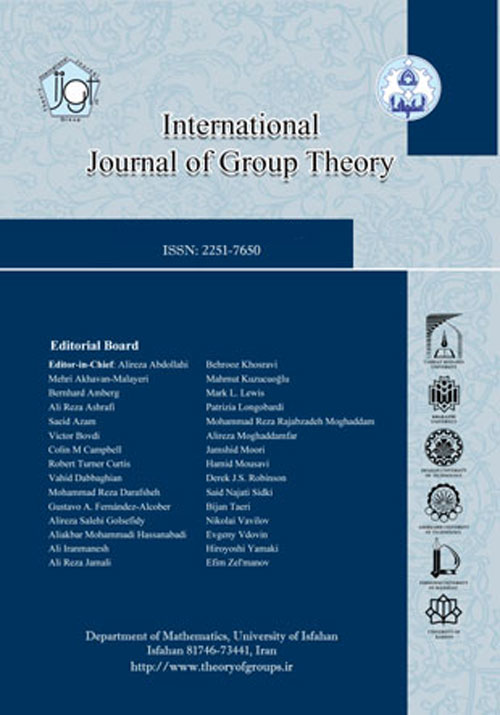فهرست مطالب

International Journal of Group Theory
Volume:5 Issue: 3, Sep 2016
- تاریخ انتشار: 1394/12/27
- تعداد عناوین: 5
-
-
Pages 1-8Darafsheh and Assari in [Normal edge-transitive Cayley graphs on non-abelian groups of order 4p, where p is a prime number, Sci. China Math. {\bf 56} (1) (2013) 213− − 219.] classified the connected normal edge transitive and frac12− frac12− arc-transitive Cayley graph of groups of order 4p 4p . In this paper we continue this work by classifying the connected Cayley graph of groups of order 2pq 2pq , p>q p>q are primes. As a consequence it is proved that Cay(G,S) Cay(G,S) is a frac12− frac12− edge-transitive Cayley graph of order 2pq 2pq , p>q p>q if and only if |S| |S| is an even integer greater than 2, S=TcupT −1 S=TcupT−1 and Tsubseteqcba i |0leqileqp−1 Tsubseteqcbai|0leqileqp−1 such that T T and T −1 T−1 are orbits of Aut(G,S) Aut(G,S) and begin{eqnarray*} G &=& langle a, b, c | a^p = b^q = c^2 = e, ac = ca, bc = cb, b^{-1}ab = a^r rangle, G &=& langle a, b, c | a^p = b^q = c^2 = e, c ac = a^{-1}, bc = cb, b^{-1}ab = a^r rangle, end{eqnarray*} where r q equiv1(modp) rqequiv1(modp).Keywords: Cayley graph, normal edge, transitive, normal arc, transitive
-
Pages 9-35For a symmetric group G:=Sym(n) G:=Sym(n) and a conjugacy class X X of involutions in G G , it is known that if the class of involutions does not have a unique fixed point, then - with a few small exceptions - given two elements a,x∈X a,x∈X , either angbraca,x angbraca,x is isomorphic to the dihedral group D 8 D8 , or there is a further element y∈X y∈X such that angbraca,y≅angbracx,y≅D angbraca,y≅angbracx,y≅D8 (P. Rowley and D. Ward, On pi pi -Product Involution Graphs in Symmetric Groups. MIMS ePrint, 2014). One natural generalisation of this to p p -elements is to consider when two conjugate p p -elements generate a wreath product of two cyclic groups of order p p . In this paper we give necessary and sufficient conditions for this in the case that our p p -elements have full support. These conditions relate to given matrices that are of circulant or permutation type, and corresponding polynomials that represent these matrices. We also consider the case that the elements do not have full support, and see why generalising our results to such elements would not be a natural generalisation.Keywords: circulant matrix, cyclic group, wreath product
-
Pages 37-47The textit{commutativity degree}, Pr(G) Pr(G) , of a finite group G G (i.e. the probability that two (randomly chosen) elements of G G commute with respect to its operation)) has been studied well by many authors. It is well-known that the best upper bound for Pr(G) Pr(G) is frac58 frac58 for a finite non--abelian group G G .
In this paper, we will define the same concept for a finite non--abelian textit{Moufang loop} M M and try to give a best upper bound for Pr(M) Pr(M) . We will prove that for a well-known class of finite Moufang loops, named textit{Chein loops}, and its modifications, this best upper bound is frac2332 frac2332 . So, our conjecture is that for any finite Moufang loop M M , Pr(M)leqfrac2332 Pr(M)leqfrac2332 .
Also, we will obtain some results related to the Pr(M) Pr(M) and ask the similar questions raised and answered in group theory about the relations between the structure of a finite group and its commutativity degree in finite Moufang loops.Keywords: Loop theory, Finite Moufang loops, Commutativity degree in finite groups -
Pages 49-60In this paper we study some relations between the power and quotient power graph of a finite group. These interesting relations motivate us to find some graph theoretical properties of the quotient power graph and the proper quotient power graph of a finite group G. In addition, we classify those groups whose quotient (proper quotient) power graphs are isomorphic to trees or paths.Keywords: Quotient power graph, Fitting subgroup, full exponent
-
Pages 61-67A group G is said to be a (PF)C-group or to have polycyclic-by-finite conjugacy classes, if G/C_{G}(x^{G}) is a polycyclic-by-finite group for all xin G. This is a generalization of the familiar property of being an FC-group. De Falco et al. (respectively, de Giovanni and Trombetti) studied groups whose proper subgroups of infinite rank have finite (respectively, polycyclic) conjugacy classes. Here we consider groups whose proper subgroups of infinite rank are (PF)C-groups and we prove that if G is a group of infinite rank having a non-trivial finite or abelian factor group and if all proper subgroups of G of infinite rank are (PF)C-groups, then so is G. We prove also that if G is a locally soluble-by-finite group of infinite rank which has no simple homomorphic images of infinite rank and whose proper subgroups of infinite rank are (PF)C-groups, then so are all proper subgroups of G.Keywords: Polycyclic, by, finite conjugacy classes, minimal non, (PF)C, group, minimal non, FC, group, Prüfer rank

